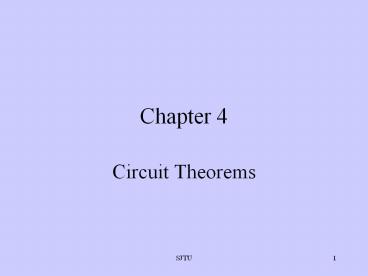Circuit Theorems - PowerPoint PPT Presentation
Title:
Circuit Theorems
Description:
Linearity is the property of an element describing a linear relationship between ... be replaced by an equivalent circuit consisting of a voltage source Vth in ... – PowerPoint PPT presentation
Number of Views:2741
Avg rating:3.0/5.0
Title: Circuit Theorems
1
Chapter 4
- Circuit Theorems
2
Linearity Property
- Linearity is the property of an element
describing a linear relationship between cause
and effect. - A linear circuit is one whose output is linearly
( or directly proportional) to its input.
3
Fig. 4.4 For Example 4.2
4
Superposition(1)
- The superposition principle states that voltage
across (or current through) an element in a
linear circuit is the algebraic sum of the
voltages across (or currents through) that
element due to each independent source acting
alone.
5
Superposition(2)
- Steps to Apply Superposition Principle
- Turn off all independent source except one
source. Find the output(voltage or current) due
to that active source using nodal or mesh
analysis. - Repeat step 1 for each of the other independent
sources. - Find the total contribution by adding
algebraically all the contributions due to the
independent sources.
6
(No Transcript)
7
Fig. 4.6 For Example 4.3
8
Source Transformation(1)
- A source transformation is the process of
replacing a voltage source Vs in series with a
resistor R by a current source is in parallel
with a resistor R, or vice versa. VsisR or
isVs/R
9
Source Transformation(2)
- It also applies to dependent sources
10
Fig. 4.17 for Example, find out Vo
11
So, we get vo3.2V
12
Example find out I (use source transformation )
I
13
Substitution Theorem
?
?
?
?
?
?
?
I12A, I21A, I31A, V38V
I12A, I21A, I31A, V38V
I12A, I21A, I31A, V38V
14
Substitution Theorem
- If the voltage across and current through any
branch of a dc bilateral network are known, this
branch can be replaced by any combination of
elements that will maintain the same voltage
across and current through the chosen branch.
15
Substitution Theorem
16
Thevenins Theorem
- A linear two-terminal circuit can be replaced by
an equivalent circuit consisting of a voltage
source Vth in series with a resistor Rth, where
Vth is the open-circuit voltage at the terminals
and Rth is the input or equivalent resistance at
the terminals when the independent source are
turned off.
17
(a) original circuit, (b) the Thevenin equivalent
circuit
18
Simple Proof by figures
VVoc-RoI
19
Thevenins Theorem
- Consider 2 cases in finding Rth
- Case 1 If the network has no dependent sources,
just turn off all independent sources, calculate
the equivalent resistance of those resistors
left. - Case 2 If the network has dependent sources,
there are two methods to get Rth
20
Thevenins Theorem
- Case 2 If the network has dependent sources,
there are two methods to get Rth - Turn off all the independent sources, apply a
voltage source v0 (or current source i0) at
terminals a and b and determine the resulting
current i0 (or resulting voltage v0), then Rth
v0/ i0
21
Thevenins Theorem
- Case 2 If the network has dependent sources,
there are two methods to get Rth - 2. Calculate the open-circuit voltage Voc and
short-circuit current Isc at the terminal of the
original circuit, then RthVoc/Isc
RthVoc/Isc
22
Examples
23
Nortons Theorem
- A linear two-terminal circuit can be replaced by
an equivalent circuit consisting of a current
source IN in parallel with a resistor RN, where
IN is the short-circuit current through the
terminals and RN is the input or equivalent
resistance at the terminals when the independent
sources are turned off.
24
(a) Original circuit, (b) Norton equivalent
circuit
25
Examples
26
Maximum Power Transfer
Replacing the original network by its Thevenin
equivalent, then the power delivered to the load
is
a
b
27
Power delivered to the load as a function of RL
28
Maximum Power Transfer(several questions)
- If the load RL is invariable, and RTh is
variable, then what should RTh be to make RL get
maximum power?
- If using Norton equivalent to replace the
original circuit, under what condition does the
maximum transfer occur?
- Is it true that the efficiency of the power
transfer is always 50 when the maximum power
transfer occurs?
29
Examples
30
Tellegen Theorem
- If there are b branches in a lumped circuit, and
the voltage uk, current ik of each branch apply
passive sign convention, then we have
31
Inference of Tellegen Theorem
- If two lumped circuits and have the same
topological graph with b branches, and the
voltage, current of each branch apply passive
sign convention, then we have not only
32
Example
33
Reciprocity Theorem
34
Reciprocity Theorem(only applicable to
reciprocity networks)
- Case 1 The current in any branch of a network,
due to a single voltage source E anywhere else in
the network, will equal the current through the
branch in which the source was originally located
if the source is placed in the branch in which
the current I was originally measured.
35
Reciprocity Theorem(only applicable to
reciprocity networks)
Case 2
36
Reciprocity Theorem(only applicable to
reciprocity networks)
Case 3
37
example
38
Source Transfer
- Voltage source transfer
An isolate voltage source can then be transferred
to a voltage source in series with a resistor.
39
Source Transfer
- Current source transfer
Examples
40
Summary
- Maximum Power Transfer
- Tellegen Theorem
- Inference of Tellegen Theorem
- Reciprocity Theorem
- Source Transfer
- Linearity Property
- Superposition
- Source Transformation
- Substitution Theorem
- Thevenins Theorem
- Nortons Theorem































